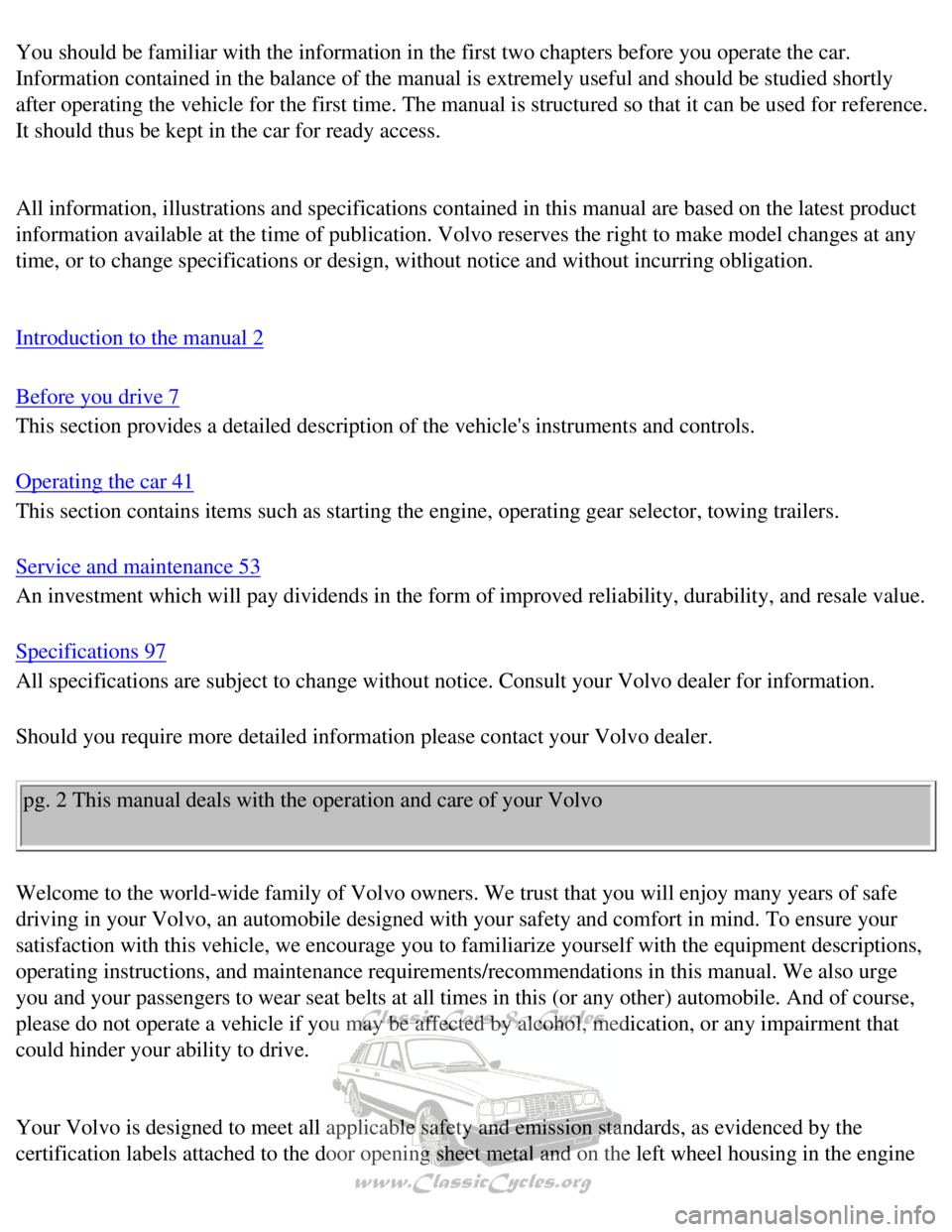Page 2 of 143

Volvo 1990 240 Model
You should be familiar with the information in the first two chapters be\
fore you operate the car.
Information contained in the balance of the manual is extremely useful a\
nd should be studied shortly
after operating the vehicle for the first time. The manual is structured\
so that it can be used for reference.
It should thus be kept in the car for ready access.
All information, illustrations and specifications contained in this manu\
al are based on the latest product
information available at the time of publication. Volvo reserves the rig\
ht to make model changes at any
time, or to change specifications or design, without notice and without \
incurring obligation.
Introduction to the manual 2
Before you drive 7
This section provides a detailed description of the vehicle's instrument\
s and controls.
Operating the car 41
This section contains items such as starting the engine, operating gear \
selector, towing trailers.
Service and maintenance 53
An investment which will pay dividends in the form of improved reliabili\
ty, durability, and resale value.
Specifications 97
All specifications are subject to change without notice. Consult your Vo\
lvo dealer for information.
Should you require more detailed information please contact your Volvo d\
ealer. pg. 2 This manual deals with the operation and care of your Volvo
Welcome to the world-wide family of Volvo owners. We trust that you will\
enjoy many years of safe
driving in your Volvo, an automobile designed with your safety and comfo\
rt in mind. To ensure your
satisfaction with this vehicle, we encourage you to familiarize yourself\
with the equipment descriptions,
operating instructions, and maintenance requirements/recommendations in \
this manual. We also urge
you and your passengers to wear seat belts at all times in this (or any\
other) automobile. And of course,
please do not operate a vehicle if you may be affected by alcohol, medic\
ation, or any impairment that
could hinder your ability to drive.
Your Volvo is designed to meet all applicable safety and emission standa\
rds, as evidenced by the
certification labels attached to the door opening sheet metal and on the\
left wheel housing in the engine
file:///K|/ownersdocs/1990/1990_240/90240_00.htm (2 of 4)12/30/2006 8:\
25:01 AM
Page 15 of 143
Volvo 1990 240 Model
Turn signals
1 Signal lever engaged for normal turns.
Note: A defective turn signal bulb will cause turn signal indicator and \
remaining signal lights to flash
more rapidly than normal.
2 Lane change position. In maneuvers such as lane changing, the driver c\
an flash the turn signals by
moving the turn signal lever to the first stop and holding it there. The\
lever will return to the neutral
position when released.
3 High and low beam switching (Headlight switch in position
).
Move the lever towards the steering wheel and release it.
3 Headlight flasher (Headlight switch in position
or 0).
Move the lever towards the steering wheel. The headlight high beam will \
be on until the lever is
released.
pg. 15 Rear fog lights, Lighting
file:///K|/ownersdocs/1990/1990_240/90240_03.htm (2 of 7)12/30/2006 8:\
25:02 AM
Page 53 of 143

Volvo 1990 240 Model
To obtain best parking brake performance, the brake linings should be br\
oken in.
Stop 5-7 times from 30 mph (50 km/h), transmission in neutral, applyin\
g the parking brake with the
release button pressed in during the stop. The force must not lock the r\
ear wheels. If this happens,
release the brake enough to let the wheels rotate. Drive a mile between \
each stop to cool the brakes.
Check for proper parking brake operation.
Note: The brake lights are not illuminated when applying the parking bra\
ke. To warn traffic from
behind it is therefore advisable to depress the brake pedal slightly to \
illuminate the brake lights.
600 - 1,200 mile maintenance service
To ensure proper operation the car should be taken to a Volvo dealer bet\
ween the first 600 - 1,200 miles
(1,000 - 2,000 km) for a maintenance service. The oil in the engine, m\
anual transmission and rear axle
will then be changed. This is very important since the oil rapidly colle\
cts impurities during the break-in
period.
pg. 43 Driving economy, Shift indicator light
Economical driving does not necessarily mean driving slowly
Better driving economy may be obtained by thinking ahead, avoiding rapid\
starts and stops and
adjusting the speed of your vehicle to immediate traffic conditions. Obs\
erve the following rules:
l Bring the engine to normal operating temperature as soon as possible by \
driving with a light foot on
the accelerator pedal instead of allowing the engine to idle for a prolo\
nged period. A cold engine uses
more fuel and is subject to increased wear.
l When possible avoid using the car for driving short distances. This does\
not allow the engine to reach
normal operating temperature.
l Drive carefully and avoid rapid acceleration and hard braking.
l Do not exceed speed limit.
l Avoid carrying unnecessary items (extra load) in the car.
l Check tire pressures regularly (cold tires).
l Remove snow tires when threat of snow or ice has ended.
l Note that roof racks, ski racks, etc., increase air resistance and there\
by fuel consumption.
file:///K|/ownersdocs/1990/1990_240/90240_09.htm (3 of 6)12/30/2006 8:\
25:05 AM
Page 70 of 143
Volvo 1990 240 Model
pg. 53 Service and maintenance
55Maintenance services
56Service requirements
59Engine B230F
60Fuel requirements
61Engine fluids
62Engine oil, Oil/oil filter change interval
63Cooling system
65Servicing
70Transmission oil
72Rear axle, power steering, brake fluid
73Lubrication
74Coolant
75Alternator, jump starting
76Replacing bulbs
81Fuses
82Wheels and tires
84Wheel changing
86Replacing wiper blades
87Washing, cleaning
87Cleaning, anti-rust treatment
88Paint touch-up
90What causes rust
91Long distance trips, cold weather
92Service diagnosis
96Label information
file:///K|/ownersdocs/1990/1990_240/90240_12.htm (1 of 7)12/30/2006 8:\
25:07 AM